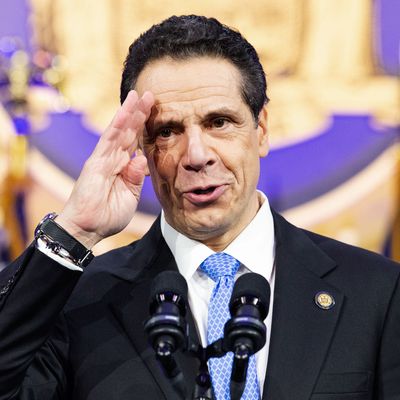
New York governor Andrew Cuomo announced Thursday that — surprise! — the long-planned L train subway shutdown between Manhattan and Brooklyn wouldn’t be necessary after all.
In the last few weeks, the governor had gathered together some smart people from the engineering schools at Columbia and Cornell, and they had poked around and figured out a way to repair damage from Hurricane Sandy with drastically less work than had been planned. Instead of closing the Canarsie tubes, which carry the L under the East River, in their entirety for 15 months, the MTA should be able to execute Cuomo’s new plan with just 15 to 20 months of night and weekend service reductions, according to acting MTA chairman Freddy Ferrer.
If this plan will work, it’s great news. But there’s an obvious question: If this plan will work, and if some engineering professors whose primary work isn’t on subway construction were able to come up with it in a matter of weeks, why didn’t anyone think of it earlier? Why did we spend three years planning for a 15-month shutdown that is, in retrospect, totally unnecessary? Is the Metropolitan Transportation Authority staffed by idiots?
I do not mean that as a rhetorical question.
We have learned over the last couple of years that the primary driver of increased subway delays is not overcrowding or deferred maintenance or budget cuts — it is a series of incompetent managerial decisions the MTA made, lowering speed limits without good cause and installing faulty sensors to enforce those limits, causing train operators to drive well below the posted limits to avoid tripping an errant emergency brake.
Andy Byford, who came to the MTA in 2017 from Toronto to run New York’s subway and bus system, has rolled out a program to fix the faulty sensors and raise speed limits where appropriate. Why didn’t anyone think of that earlier? Had the MTA been staffed by idiots? Quite possibly, yes.
The embarrassing implication of Cuomo’s Thursday announcement is that, until his intervention, the MTA had been preparing to do something very wasteful and stupid. Since the MTA is an agency that routinely sets tunnel-construction-cost world records, I am entirely prepared to believe that is true.
But I am also prepared to believe that it is false. Cuomo, who has often shown little interest in the subway agency he can’t bring himself to admit he controls, is not an expert on subway construction or maintenance. He has a past track record of meddling in negative ways in capital projects. While I don’t trust the MTA to make smart choices, I don’t trust him, either.
The main Cuomo-driven change to the Canarsie tube project is a decision not to replace all the “bench walls.” These are concrete platforms that run on either side of the train, concealing electric cables and providing a walkway for maintenance and emergency egress. Because the bench walls run along both sides of both tracks, there are 32,000 feet of them in total, and they have been weakened from the days they spent soaking in salt water after Hurricane Sandy, which has in turn exposed electrical cables to damage and reduced system reliability.
Demolishing and rebuilding six miles of such walls without damaging the surrounding tunnel shell was the main, time-consuming project that was supposed to require such a long closure. But Cuomo and his outside engineers now say the MTA can run new electric cabling outside the bench walls, strung on racks on the side of the tunnel itself. Therefore, they can abandon the old electric cables within the bench walls and don’t have to worry about rebuilding them; they can rebuild only the parts of the walls that are literally crumbling, and reinforce the rest with fiberglass.
Sounds great. But in 2016, the MTA said replacing all the bench walls wasn’t just necessary to fix the electrical system. It was necessary “to protect the structural integrity of the two tubes that carry trains through the tunnel,” they said. Were they lying? Mistaken? Incompetent?
Again, I am open to the answer to one or more of those questions being “yes,” but we do need an answer.
I do not feel as negatively about Cuomo’s eleventh-hour intervention as a lot of commentators do. If Cuomo proves to have been right about this, he will have done New Yorkers a great service; better late than never. And there may even be lessons that could be taken from a successful patch job of these tunnels for the North River Tunnels connecting Manhattan and New Jersey. The eventual need to replace aging bench walls in these tunnels is one of the key reasons to fear an eventual disruption that severely impairs service on Amtrak’s Northeast Corridor.
I have been complaining for years that the MTA fails to adopt best practices from around the world that would allow it to build and operate its infrastructure better and more cheaply — and that this failure is the main reason we, one of the wealthiest cities in the world, can “barely afford” to expand our transit infrastructure. Now, Cuomo has inserted himself in the MTA’s operations, declared his intention to take on the “transportation-industrial complex” and — in a haphazard and ill-timed manner — urged the agency to look at a cheaper, better cabling idea he found in Europe.
I can fault the late timing, but I can’t fault the impulse. Let’s hope this plan proves workable as the MTA hashes out the details over the coming weeks and months, and let’s hope this taste of being the Subway Savior encourages Cuomo to take a more proactive role as the ultimate overseer of New York’s subways. Lord knows the MTA needs the oversight.





























